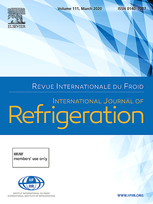
Recommandé par l'IIF / Document IIF
Une nouvelle approche de dégivrage à la demande basée sur l’épaisseur de givre en temps réel pour la conservation de l’énergie d’un réfrigérateur.
A novel demand-actuated defrost approach based on the real-time thickness of frost for the energy conservation of a refrigerator.
Auteurs : MALIK A. N., KHAN S. A., LAZOGLU I.
Type d'article : Article de la RIF
Résumé
The typical domestic refrigerator employs a blind and periodic defrost strategy that leads to the clogging of the evaporator between the consecutive defrost cycles. The clogging of the evaporator causes a loss in performance which can be minimized using the demand defrost technique. The demand defrost systems proposed in the literature rely on the detection of frost as the defrost triggering criterion, rather than the real-time quantification of the thickness of frost. The initial frost layer improves the performance and therefore, the thickness of frost must be taken into consideration. Frost becomes detrimental only after it crosses a critical threshold. Defrosting the system at lower thicknesses may lead to frequent defrosting cycles which in turn increases the defrost energy. Therefore, the defrost triggering criterion must be selected tactfully to utilize the benefit of the initial frost layer along with the minimization of the defrost energy. In this article, a novel real-time thickness of the frost-based demand defrost technique is presented for a domestic refrigerator. A hybrid system comprised of a frost detection and defrosting modules is employed to quantify the thickness of frost in real-time and to defrost the evaporator using a 12 W heater. The effect of the thickness of the frost-based defrost threshold on the energy consumption of the refrigerator is evaluated. The defrost threshold of 6 mm yields the maximum energy conservation of 10% as compared to the default blind and periodic defrost strategy of the test refrigerator.
Détails
- Titre original : A novel demand-actuated defrost approach based on the real-time thickness of frost for the energy conservation of a refrigerator.
- Identifiant de la fiche : 30029125
- Langues : Anglais
- Source : International Journal of Refrigeration - Revue Internationale du Froid - vol. 131
- Date d'édition : 11/2021
- DOI : http://dx.doi.org/10.1016/j.ijrefrig.2021.07.032
- Document disponible en consultation à la bibliothèque du siège de l'IIF uniquement.
Liens
Voir d'autres articles du même numéro (95)
Voir la source
-
Experimental study on a new finned tube defrost...
- Auteurs : YANG P., YANG X., LIU Y.
- Date : 12/2023
- Langues : Anglais
- Source : International Journal of Refrigeration - Revue Internationale du Froid - Vol. 156
- Formats : PDF
Voir la fiche
-
Improving cooling efficiency in domestic refrig...
- Auteurs : NICOLETTI F., AZZARITO G., SYLAJ D.
- Date : 03/2024
- Langues : Anglais
- Source : International Journal of Refrigeration - Revue Internationale du Froid - vol. 159
- Formats : PDF
Voir la fiche
-
Experimental study on a new type of thermal sto...
- Auteurs : LIU Z., LI A., WANG Q., et al.
- Date : 25/05/2017
- Langues : Anglais
- Source : Applied Thermal Engineering - vol. 118
Voir la fiche
-
Exergoeconomic performance comparison of R1234y...
- Auteurs : RANGEL-HERNANDEZ V. H., BELMAN-FLORES J. M., RODRIGEZ-VALDERRAMA D. A., et al.
- Date : 04/2019
- Langues : Anglais
- Source : International Journal of Refrigeration - Revue Internationale du Froid - vol. 100
- Formats : PDF
Voir la fiche
-
AUGMENTATION DE L'EFFICACITE ENERGETIQUE DES RE...
- Auteurs : PLUZNIKOV O. N.
- Date : 1991
- Langues : Russe
- Source : Kholodilnaya Tekhnika - n. 2
Voir la fiche
